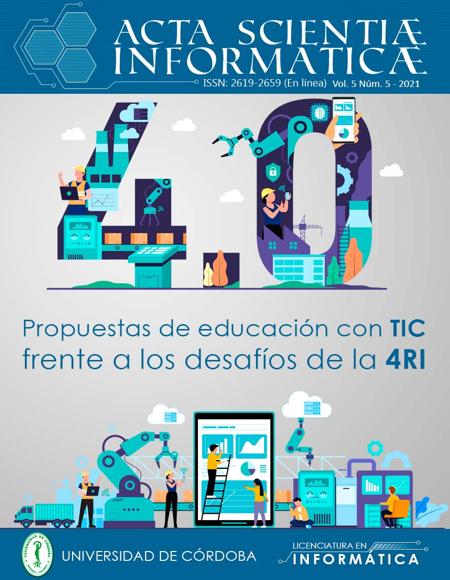Mostrar biografía de los autores
El presente artículo, es una investigación de carácter teórica sobre Learning Analytics (analítica del aprendizaje) vista desde la perspectiva de diversos autores, como una herramienta integradora e incluyente en la educación superior.
Para la construcción de este trabajo investigativo, se hizo una profunda búsqueda de documentos; examinando literaturas de diversos tipos como archivos, revistas, entre otros; relacionados con la temática y se tuvo en cuenta el año de publicación, la relevancia en el texto, las palabras claves que enmarcan el contexto y la profundización del tema a desarrollar.
Visitas del artículo 236 | Visitas PDF
Descargas
- R. C. Chick et al., “Using Technology to Maintain the Education of Residents During the COVID-19 Pandemic,” J. Surg. Educ., 2020, doi: 10.1016/j.jsurg.2020.03.018.
- E. E. C. Garay and M. A. Arrúa, “Impact of COVID-19 on university dropouts from business careers,” UNE, pp. 40–50, 2021.
- C. Roldán, “Predicción de la Deserción Estudiantil y Aplicación de Learning Analytics en la Escuela Ing. Cassaffousth Ing.,” vol. 21, no. 1, pp. 1–9, 2020.
- I. Hilliger et al., “Identifying needs for learning analytics adoption in Latin American universities: A mixed-methods approach,” Internet High. Educ., vol. 45, no. April 2019, p. 100726, 2020, doi: 10.1016/j.iheduc.2020.100726.
- A. Chiappe, L. P. Rodríguez, A. Chiappe, and L. P. Rodríguez, “Learning Analytics in 21st century education: a review,” Ens. Avaliação e Políticas Públicas em Educ., vol. 25, no. 97, pp. 971–991, Jun. 2017, doi: 10.1590/s0104-40362017002501211.
- R. Vuorikari et al., “Las Analíticas de Aprendizaje: evidencias e investigación sobre su uso Implicaciones para la política y la práctica,” Madrid, 2017. doi: 10.2791/955210.
- S. Dawson, S. Joksimovic, O. Poquet, and G. Siemens, “Increasing the impact of learning analytics,” ACM Int. Conf. Proceeding Ser., no. March, pp. 446–455, 2019, doi: 10.1145/3303772.3303784.
- M. A. Chatti, A. L. Dyckhoff, U. Schroeder, and H. Thüs, “A reference model for learning analytics,” Int. J. Technol. Enhanc. Learn., vol. 4, no. 5–6, pp. 318–331, 2018, doi: 10.1504/IJTEL.2012.051815.
- P. Rojas Castro, “Learning Analytics. Una Revisión de la Literatura,” Educ. y Educ., vol. 20, no. 1, pp. 106–128, Feb. 2017, doi: 10.5294/edu.2017.20.1.6.
- D. A. Filvà, M. A. Forment, F. J. García-Peñalvo, D. F. Escudero, and M. J. Casañ, “Learning analytics to assess students’ behavior with Scratch,” Futur. Gener. Comput. Syst., vol. 93, pp. 673–686, 2019, doi: 10.1016/j.future.2018.10.057.
- F. Simanca, “Sistema De Mejora Del Rendimiento Académico Mediante Learning Analytics,” p. 272, 2018.
- T. Martin and B. Sherin, “Learning Analytics and Computational Techniques for Detecting and Evaluating Patterns in Learning: An Introduction to the Special Issue,” J. Learn. Sci., vol. 22, no. 4, pp. 511–520, 2013, doi: 10.1080/10508406.2013.840466.
- A. G. Picciano, “The evolution of big data and learning analytics in american higher education,” J. Asynchronous Learn. Netw., vol. 16, no. 3, pp. 9–20, 2012, doi: 10.24059/olj.v16i3.267.
- G. Siemens, “Learning Analytics: The Emergence of a Discipline,” Am. Behav. Sci., vol. 57, no. 10, pp. 1380–1400, 2013, doi: 10.1177/0002764213498851.
- P. Long and G. Siemens, “Penetrating the Fog: Analytics Learning in Education,” Educause, vol. 29, no. 3, pp. 237–240, 2011, doi: 10.1177/0894318416647779.
- V. Kovanović et al., “Understand students’ self-Reflections through learning analytics,” ACM Int. Conf. Proceeding Ser., pp. 389–398, 2018, doi: 10.1145/3170358.3170374.
- Moodle, “Analytics,” 2020. https://docs.moodle.org/39/en/Analytics (accessed Oct. 07, 2020).
- L. Kart, “Big Data Industry Insights.” Gartner, p. 43, 2015, [Online]. Available: http://proyectos.andi.com.co/camarabpo/Webinar 2016/Big data industry insights- Gartner.pdf.
- K. Verbert, X. Ochoa, R. De Croon, R. A. Dourado, and T. De Laet, “Learning analytics dashboards: The past, the present and the future,” ACM Int. Conf. Proceeding Ser., pp. 35–40, 2020, doi: 10.1145/3375462.3375504.
- K. Lepenioti, A. Bousdekis, D. Apostolou, and G. Mentzas, “Prescriptive analytics: Literature review and research challenges,” Int. J. Inf. Manage., vol. 50, no. October 2018, pp. 57–70, 2020, doi: 10.1016/j.ijinfomgt.2019.04.003.
- Y. Liu, G. Mao, V. Leiva, S. Liu, and A. Tapia, “Diagnostic analytics for an autoregressive model under the skew-normal distribution,” Mathematics, vol. 8, no. 5, pp. 1–19, 2020, doi: 10.3390/MATH8050693.
- T. Doleck, D. J. Lemay, R. B. Basnet, and P. Bazelais, “Predictive analytics in education: a comparison of deep learning frameworks,” Educ. Inf. Technol., vol. 25, no. 3, pp. 1951–1963, 2020, doi: 10.1007/s10639-019-10068-4.
- C. Schumacher and D. Ifenthaler, “Features Students Really Expect From,” no. Celda, pp. 67–76, 2016.
- X. Zhang et al., “Accessibility within open educational resources and practices for disabled learners: a systematic literature review,” Smart Learn. Environ., vol. 2, pp. 1–19, 2020, doi: 10.1186/s40561-019-0113-2.
- K. Yamada et al., Integrating Multimodal Learning Analytics and Inclusive Learning Support Systems for People of All Ages, vol. 11577 LNCS. 2019.


